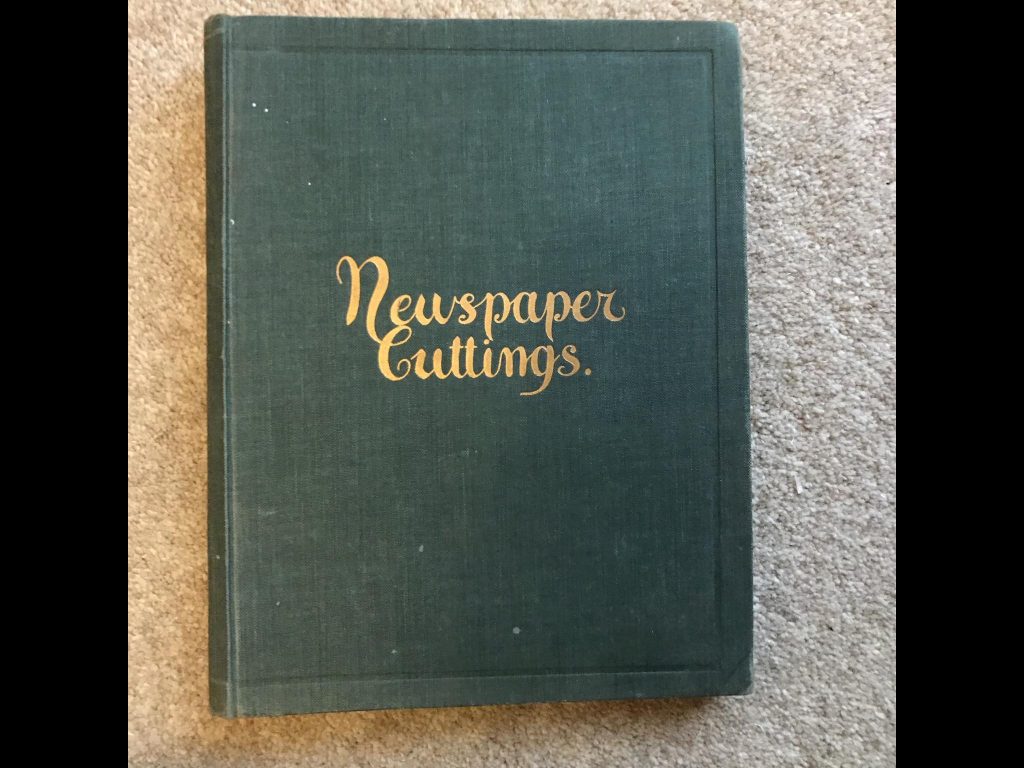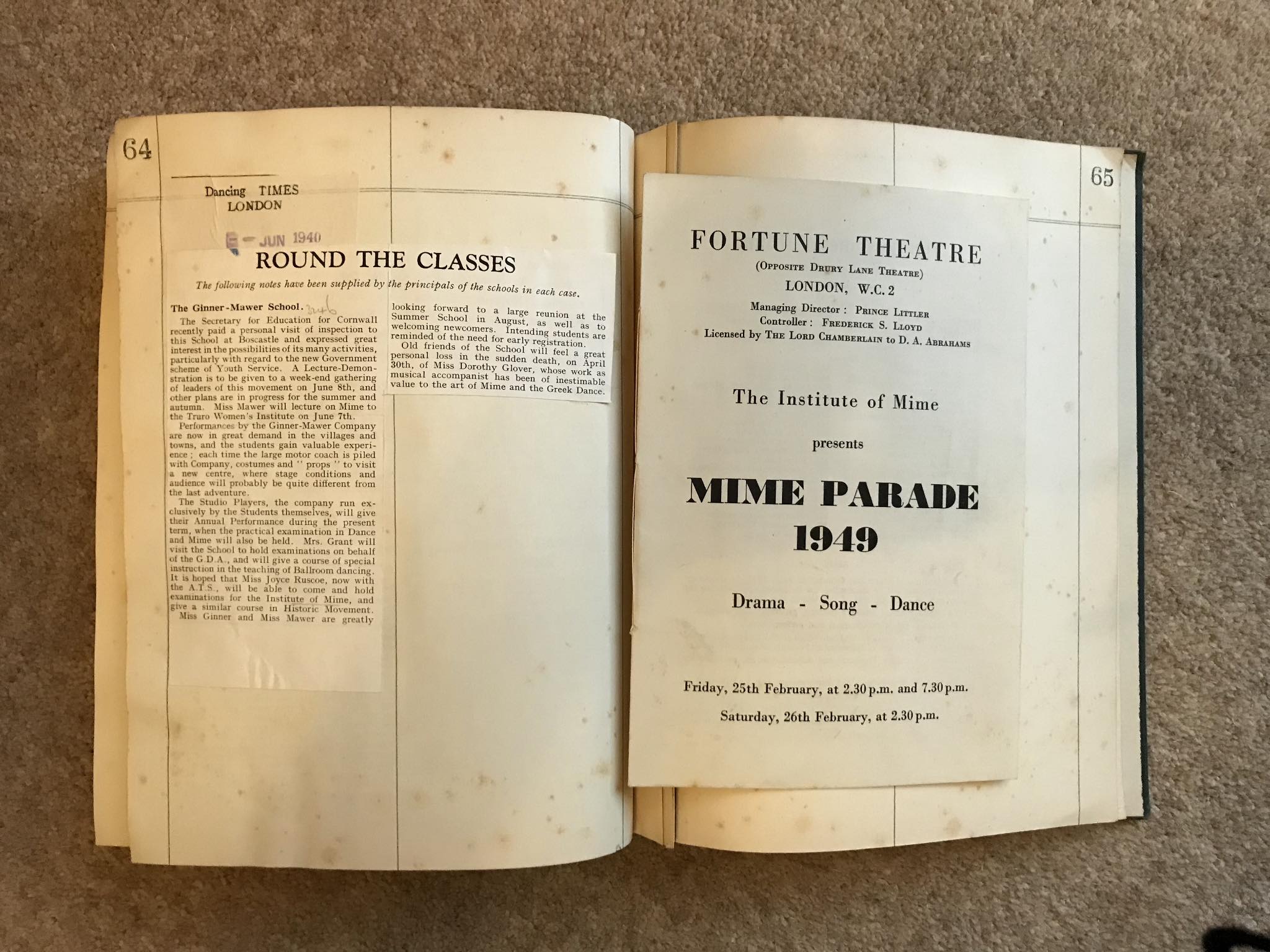JUNE 1940
At the time of her death, Irene Mawer left among her personal belongings a hard-backed book with a greeny-black cover, the front of which is embossed with gold lettering spelling out the words Newspaper Cuttings.
Roughly A4 in size, the book contains a large collection of newspaper clippings, covering the Ginner-Mawer career partnership.
The photograph which is attached to this blog post shows an article from the Dancing Times, published in June 1940. (The Ginner-Mawer School had moved to Boscastle in Cornwall, during the autumn or winter of 1939, to avoid the bombs of London during the Second World War.)
The newspaper article begins by stating that the Secretary for Education for Cornwall had already paid a visit to the Ginner-Mawer School. I don’t know if this was a legal requirement, or if it was a visit at the invitation of Irene Mawer. Miss Mawer would, I feel, have very much wanted the visit as she was a great educator and would probably have wanted to be involved with the Youth Service which is mentioned in the article.
However, I don’t know what became of these hopes – I have not come across any other reference to School activities in regard to the Youth Service. From the article, it sounds as if the Youth Service was a small but growing movement and the Ginner-Mawer School gave a Lecture-Demonstration to a week-end gathering of Youth Service leaders. I will need to do some more research into the Youth Movement, to find out what became of it. I have never heard of it before – so perhaps nothing ever came of it.

Throughout her career, Irene Mawer spent much of her time working alongside the Women’s Institute (WI) and the newspaper article mentions that she had recently given a lecture on Mime to the WI in Truro, a distance of 82 miles round trip. I would imagine that as well as being an outlet for the educational side of things, these lectures and workshops were also a source of income for the Ginner-Mawer School.
Although I don’t know the exact date of the move to Boscastle, the newspaper article states that by the summer of 1940 performances by the students were in great demand around the local area. However, it should be noted that the authors of the article were Irene Mawer and Ruby Ginner themselves, so they would have written positively about their successes. It is interesting to see that the School hired a large coach to transport not only the students, but also everything that they needed to put on a performance. Known as the Studio Players, the students of the Ginner-Mawer School gained a huge amount of experience from this style of performing – arriving at an unknown destination and having to quickly adjust to new stages and situations.
In addition to performing around Cornwall, the Studio Players also gave a performance each year, to demonstrate their skills and the scope of the teaching of the School. At the time of the publication of the article, the Studio Players were due to give this performance and at the same time, there would also be the practical exams of the Dance and of the Mime.
There is a Mrs Grant referred to as being a visitor to the School and who would hold the examination on behalf of the Greek Dance Association (GDA). I have not come across Mrs Grant before, and the article notes that while she was at the School, she would also give instruction in how to teach Ballroom dancing. This would be a good use of her time – especially during the war, when traveling must have been difficult and expensive.
Miss Joyce Ruscoe is mentioned, as well. Back in 1928 there was a Ginner-Mawer pupil named Joyce Roscoe, who I think is the same person as Joyce Ruscoe (her name was regularly mis-spelled which must have been a source of irritation for her). In 1938 (if this is the same person), Joyce opened a British Drama League school in Buxton, Derbyshire. I am unclear as to whether this was her own school, or whether it was a summer school run by the British Drama League. Either way, at that time (1938) Joyce Ruscoe was a Fellow and also the Vice President of the Institute of Mime (founded by Irene Mawer). The newspaper article states that Joyce Ruscoe was with the ATS. I don’t know what this was – a quick Google search returns results for the American Tribal Style Belly Dance. I wonder what Irene would have made of that!
The School were hopeful that Miss Ruscoe could attend as if she did, she would also hold examinations for the Institute of Mime and also give a course in Historic Movement. From my own mime training during the 1980s, I know that period movement was a very important part of the mime syllabus and I imagine a great deal of time would have been spent in learning how to move as if one were wearing clothes of any given period in history (male and female).
The newspaper article then looks ahead to August, when the annual Summer School was expected to be held. Some photos exist in a private collection which are taken in Boscastle and I think might show the students of the Summer School. The photographs are rather fanciful to the modern eye, but they must have been exhilarating to be part of at the time. The photos show groups of young women dressed in Classical Greek clothing, draping themselves over the Cornish coastal rocks; the sea behind them, while tunics and scarves blew gently in the summer sea breeze.
A sad note brings us to the end of the newspaper article, which records the death of Miss Dorothy Glover, “whose work as musical accompanist has been of inestimable value to the art of Mime and Greek Dance”. It is good that I have found the exact date of death, as I can now go back and work out if the Dorothy Glover who was the girlfriend of Graham Greene, is the same person as the Ginner-Mawer associate. I am guessing they are not one and the same…I shall investigate and let you know the outcome.

